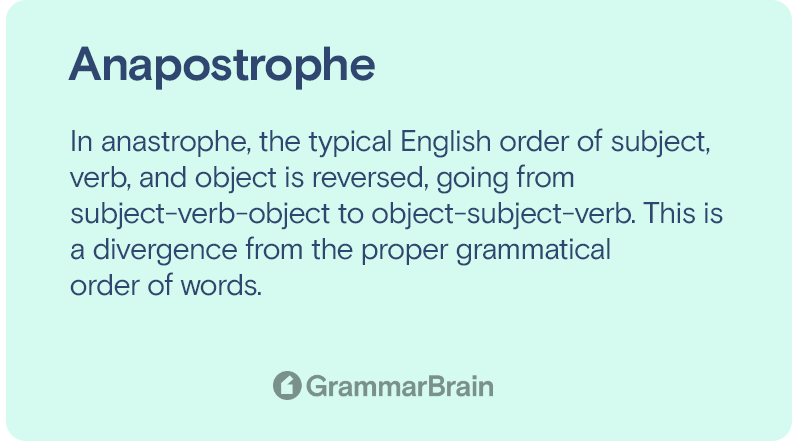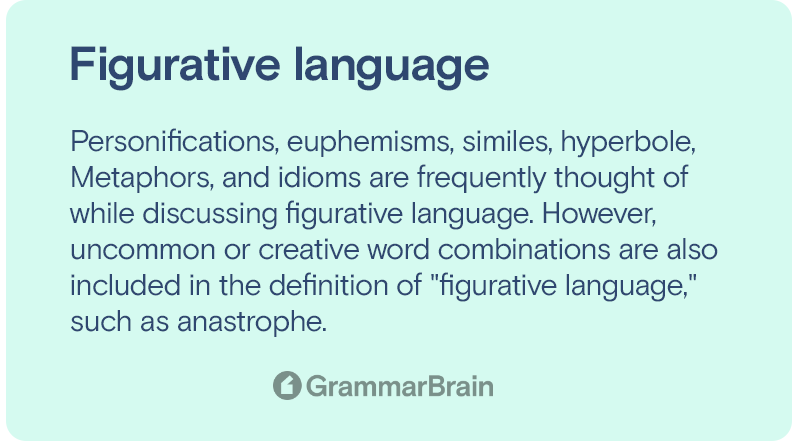What is anastrophe? How does it work? How is it used in American literature? These are all great questions that will get answered in this comprehensive guide on anastrophe. Continue reading to learn more.

What is anastrophe?
In anastrophe (related to transferred epithet or hyperbaton, transcensio, transgressio, and tresspasser) , the typical English order of subject, verb, and object is reversed, going from subject-verb-object to object-subject-verb. This is a divergence from the proper grammatical order of words.
Poetry frequently employs anastrophe as a means of creating a rhythmic effect.
Although it is occasionally referred to as a more precise instance of hyperbaton—the shifting of just one word—it is also a synonym for hyperbaton.
How does anastrophe work?
Prose and poetry employ anastrophe to establish a particular syllabic pattern or style. Sometimes a writer must adhere to a metrical pattern, which necessitates that the stresses or emphasized beats occur in atypical locations. A similar procedure is sometimes used to make rhymes.
In Greek, anastrophe means “turning around.” Anastrophe flips the subject-verb-object order that English sentence structure often uses for effect.

Understanding figurative language and anastrophe:
Personifications, euphemisms, similes, hyperbole, Metaphors, and idioms are frequently thought of while discussing figurative language. However, uncommon or creative word combinations are also included in the definition of “figurative language,” such as anastrophe.
Examples of anastrophe
Following are examples that will help you understand the use of anastrophe.
Star Wars
Yoda from the Star Wars movies is one of the most well-known figures who use anagrams. He adds, “The greatest teacher, failure is,” when he wishes to convey the idea that failure is the best teacher. After the object in the sentence, the subject and verb (failure and is) are used (the greatest teacher). Here are some literary works that use anastrophe for narrative or dialectical effect.
1984
The dystopian novel 1984 by George Orwell uses language to mirror society’s flawed thinking. See how he employs tragedy to emphasize the strength of physical suffering:
“Of pain you could wish only one thing: that it should stop. Nothing in the world was so bad as physical pain. In the face of pain there are no heroes.“ (1984, Orwell)
Orwell inverts the first and second parts of the statement rather than putting it in the conventional syntax (“There are no heroes in the face of sorrow”). It enables him to complete the statement with the ominous phrase “there are no heroes” and to repeat the word “pain” as closely as possible to its prior usage.
Poem: Ireland With Emily
John Betjeman, one of the most well-known contemporary English poets, uses this technique in his poem “Ireland with Emily.” This essay provides a complex account of Ireland, its people, and its history as seen from the outside. The most significant aspects of this poem are the vivid natural imagery and deeply felt portrayals of space. The emphasis put on such passages of text serves as proof of this. See if you can identify the anastrophic phrase in the following lines from the first stanza:
“Bells are booming down the bohreens,
White the mist along the grass,
Now the Julias, Maeves and Maureens
Move between the fields to Mass.
Twisted trees of small green apple
Guard the decent, whitewashed chapel,”
Source
This section’s fifth line gives the reader a fantastic illustration of how anastrophe can be used to preserve the rhythm and finish a rhyme. To make “apple” rhyme with “chapel” in the line below, the word has been shifted to the end of the line. This statement has a strong poetic quality to it. It has the feel of a poem.
Poem: To A Captious Critic
Dunbar used this brief poem to demonstrate his enduring distaste for critics and literary criticism. And anyone who believes they know more about writing than those who deal with it. These few sentences use formal language that ridicules and imitates a critic who might be critical of a writer’s works. The complete poem is comprised of the following four lines:
Dear critic, who my lightness so deplores,
Would I might study to be prince of bores,
Right wisely would I rule that dull estate—
These lines are difficult to read rapidly. It takes some time to go over each and thoroughly comprehend them. Dunbar rearranges the words. To make “bores” rhyme with “deplores” in the first line, he says, “… I might study to be the ruler of bores.” The third and fourth lines are comparable. He utilizes anastrophe to express “Right wisely would I rule” rather than “I would rule right wisely” so that “estate” and “abdicate” end the lines.
Emphatic Word Order:
Anastrophe is frequently employed to emphasize a point. Think of a humorous illustration. The boss with the pointy hair says on March 5, 1998, Dilbert comic strip that he will start implementing the “chaos theory of management.” Wally, a coworker of Dilbert’s, responds, “And this will be different how?”
The interrogative adverb “how” is typically placed at the start of the sentence (as in “How would this be different?”). Wally emphasizes the issue of difference more by departing from the standard wording. Wally’s additional emphasis shows that the new hypothesis won’t significantly alter the boss’s behavior. Source
In Films
In literature, anastrophe refers to an odd arrangement, an inversion of what makes sense or is typical, while in film, it refers to an image’s angle, focus, and lighting. It includes every type of technological distortion. This figure should be used sparingly; its intended impact isn’t always sure.
One of the two signalmen is taken in the Ballad of a Soldier (Grigori Chukhrai), and the other flees while being pursued by a German tank. The chase is shown in a down-air shot as the camera pans to the tank and the man.
At one moment, the scene changes to show the ground up and the sky in the bottom right. Is it the man’s confused terror as he runs erratically without a strategy, or is it the tank driver’s hysterical mentality as he chases after one man?
And all this when he should be addressing himself to the destruction of businesses when he could shoot? An absurd conduct seems to need a cataclysmic response. [Source]
Why is anastrophe important?
Prose and poetry employ anastrophe to establish a specific syllabic pattern or style.
Sometimes a writer must adhere to a metrical pattern, which necessitates that the stresses or emphasized beats occur in atypical locations.
A similar procedure is sometimes used to make rhymes.
FAQs
Where does the word ‘anastrophe’ come from?
The phrase is Greek in origin and means “a turning back or around.” Instances date back to Latin and Ancient Greek poetry. Take the Aeneid as an illustration. English translation of the opening lines of
Virgil’s epic poem: “I sing of arms and the man, who first left the shores of Troy.”
In more recent times, Samuel Taylor Coleridge and Gerard Manley Hopkins are two of the most well-known poets that employ this style.
Why is anastrophe used?
It can be used to change the beat or meter, but it can also be done to emphasize a particular word or group of words.
These lines now have a different syntax, making it more challenging to understand them even though they can still be read. It highlights the displaced word(s) and gives them a poetic quality.
How can a writer invert the sentence using anastrophe?
What is an anastrophe?
A departure from a normal word order for the sake of emphasis is considered anastrophe. Yoda’s speech in Star Wars is a great example of anastrophe. His words in the speech went into an opposite direction of what we might originally anticipate.
Inside this article
Fact checked:
Content is rigorously reviewed by a team of qualified and experienced fact checkers. Fact checkers review articles for factual accuracy, relevance, and timeliness. Learn more.
Core lessons
Glossary
- Abstract Noun
- Accusative Case
- Anecdote
- Antonym
- Active Sentence
- Adverb
- Adjective
- Allegory
- Alliteration
- Adjective Clause
- Adjective Phrase
- Ampersand
- Anastrophe
- Adverbial Clause
- Appositive Phrase
- Clause
- Compound Adjective
- Complex Sentence
- Compound Words
- Compound Predicate
- Common Noun
- Comparative Adjective
- Comparative and Superlative
- Compound Noun
- Compound Subject
- Compound Sentence
- Copular Verb
- Collective Noun
- Colloquialism
- Conciseness
- Consonance
- Conditional
- Concrete Noun
- Conjunction
- Conjugation
- Conditional Sentence
- Comma Splice
- Correlative Conjunction
- Coordinating Conjunction
- Coordinate Adjective
- Cumulative Adjective
- Dative Case
- Determiner
- Declarative Sentence
- Declarative Statement
- Direct Object Pronoun
- Direct Object
- Diction
- Diphthong
- Dangling Modifier
- Demonstrative Pronoun
- Demonstrative Adjective
- Direct Characterization
- Definite Article
- Doublespeak
- False Dilemma Fallacy
- Future Perfect Progressive
- Future Simple
- Future Perfect Continuous
- Future Perfect
- First Conditional
- Irregular Adjective
- Irregular Verb
- Imperative Sentence
- Indefinite Article
- Intransitive Verb
- Introductory Phrase
- Indefinite Pronoun
- Indirect Characterization
- Interrogative Sentence
- Intensive Pronoun
- Inanimate Object
- Indefinite Tense
- Infinitive Phrase
- Interjection
- Intensifier
- Infinitive
- Indicative Mood
- Participle
- Parallelism
- Prepositional Phrase
- Past Simple Tense
- Past Continuous Tense
- Past Perfect Tense
- Past Progressive Tense
- Present Simple Tense
- Present Perfect Tense
- Personal Pronoun
- Personification
- Persuasive Writing
- Parallel Structure
- Phrasal Verb
- Predicate Adjective
- Predicate Nominative
- Phonetic Language
- Plural Noun
- Punctuation
- Punctuation Marks
- Preposition
- Preposition of Place
- Parts of Speech
- Possessive Adjective
- Possessive Determiner
- Possessive Case
- Possessive Noun
- Proper Adjective
- Proper Noun
- Present Participle
- Prefix
- Predicate



